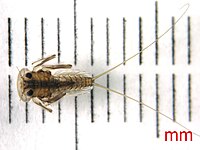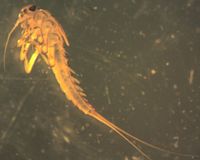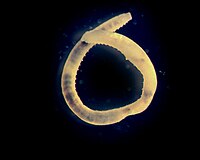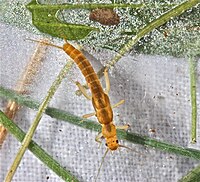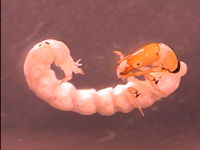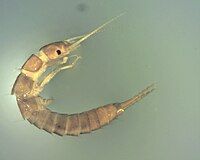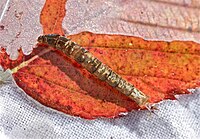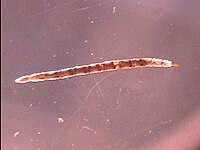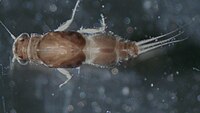Pine Brook
From WikiEducator
The following are the most common invertebrates collected from this stream site.
Contents
Heptageniidae
- Order
- Ephemeroptera
- Family
- Heptageniidae
- Common name
- flatheaded mayfly
- Tied fly
- Light Cahill, Wingless Pale Evening Dun
This family of mayflies can be characterized by their distinctly flattened heads and striking resemblance of the character 'Jack Skellington' from the movie 'The Nightmare Before Christmas.' This family can either have two or three cerci (tails).
Commonly encountered genera include:
Chironomidae
Midge larvae tend to be the most common macroinvertebrate at our sites. As with other Diptera, there are no true jointed legs. Chironomidae do have a pair of prolegs at each end and preserved individuals tend to curl into a 'C'. Identification past family requires slide-mounted heads. We have seen philopotamid caddisflies misidentified with the chironomids and we suspect that that happens when samples are being sorted from trays. Under a microscope, six prominent legs can be seen on members of the caddisfly family Philopotamidae.
More information on Philopotamidae.
Baetidae
This mayfly has either two or three cerci ("tails") and a unique head shape. Its gills are oval shaped and insert dorsally. Commonly encountered genera include Acerpenna, Baetis and Pseudocloeon.
More information on the genera:
Oligochaeta
Aquatic earthworms lack legs and are characterized by having 20 or more segments. Unlike leeches, they lack a suction disk. We collect members of two or more orders in this class as small numbers of stream sites and they are rarely numerous. They are more common at pond and lake sites.
Image of the 20 or more segments.
Leuctra
This family of stonefly is fairly slender by stonefly standards. The divergent wing pads are a helpful characteristic. Leuctridae are similar in overall shape to the Capniidae; however, Leuctridae often do not have pleural folds. If they are present, they only extend from abdominal segments 1-7. Leuctra are recognized by abdominal terga with posterior fringes of short hairs and last few segments with longer hairs.
Image of the divergent wing pads.
Philopotamidae
Philopotomidae are net-spinning filtering collectors. A casual observer might sort them with Chironomidae, but a close look reveals six jointed legs. The faint white 'T' shaped labrum extending from the front of the head past the mandibles is diagnostic for the family (it is sometimes withdrawn and hard to see).
Image of the faint white 'T' shaped labrum. Common genera include Dolophilodes, Wormaldia, and Chimarra.
Perlodidae
Stoneflies in the Perlodidae family do not have branching gills from leg bases. When observing their mouthparts, the glossae and paraglossae form a large three-pronged notch, or opening. The hind wing pads are divergent. Cerci, or "tails," are as long or longer than the abdomen.
Images of mouthparts, thehind wing pads and the ventral view.
Hexatoma
This Tipulidae can be identified by the swollen 7th abdominal segment. The swelling is bulbous and frequently as much as 2X abdominal diameter in preserved specimens.
Ceratopogonidae
Members of this family look like very straight Chironomidae. They are very long and thin with a distinct head capsule and no prolegs. Some in the lab call them 'bamboo sticks' with eyes.
Image of the distinct head capsule.
Caenidae
These "small square-gill" mayflies have operculate (plate-like) gills on segment 2 that cover gills on segments 3 to 6. Their bodies are built for crawling, and their heads are held vertically. The genus Caenis is commonly found.
More information on Caenis.

